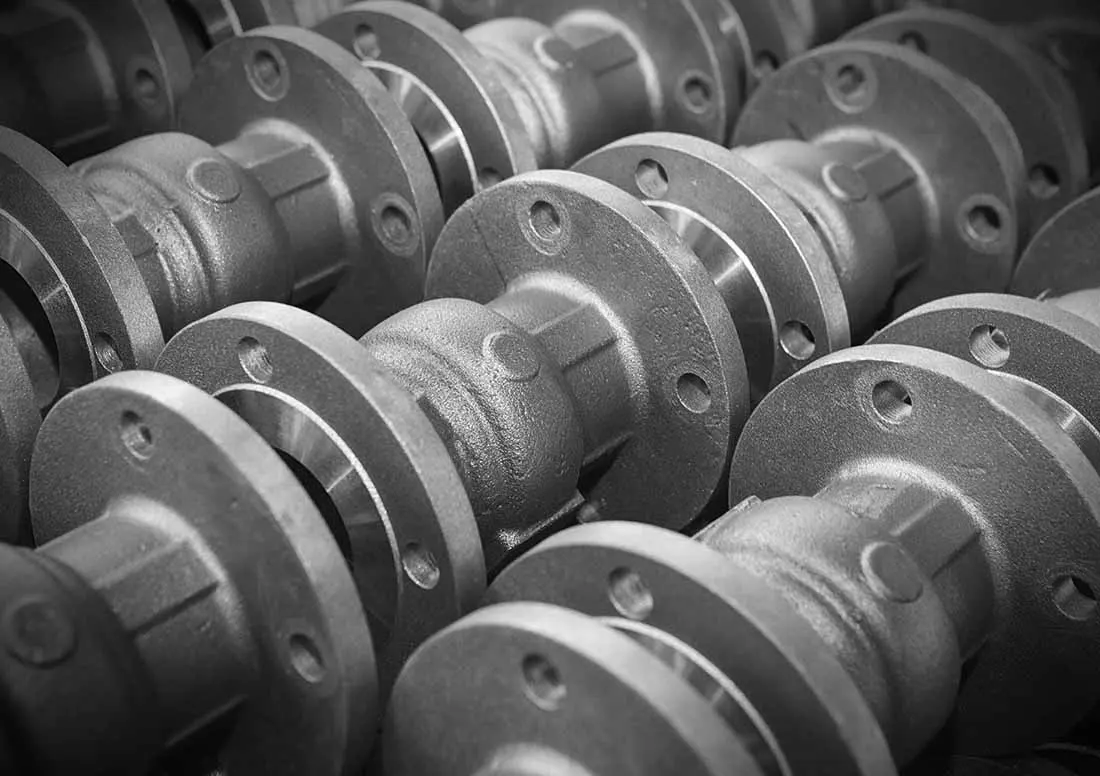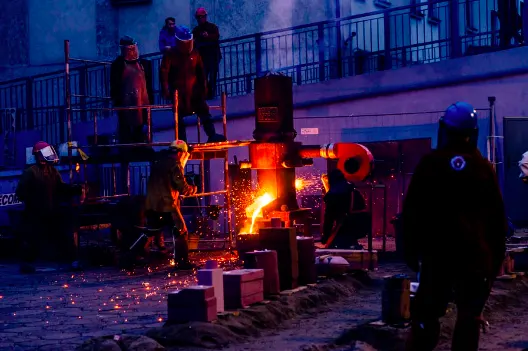
Carbon steel is one of the prominent manufacturing materials that continue to provide basis for many different industries ranging from aerospace and automotive to heavy machinery. Carbon steel being one of the cost-effective materials in casting gives an excellent balance of strength, durability, and machinability, making this an invaluable candidate for various engineering applications. The most common investment casting process is also called the "lost wax" process-a production process in which the molten metal is cast into a mold from a wax die that is then stripped. This, in turn, can create complex shapes with outstanding dimensional accuracy.
Carbon steel investment casting is a potent tool that meets the most severe demands when combined in modern engineering. It finds its application in the manufacture of parts that necessitate strength, toughness, endurance, and accuracy in tolerance. Due to the ever-growing complexities of engineering systems and higher demand for parts operating under extreme conditions, carbon steel investment casting has grown as one of the favored methods for manufacturing both critical components and high-performance solutions.
What is Carbon Steel Investment Casting?
It's important to know about the process of investment casting to appreciate the significance of carbon steel investment casting. Investment casting is one of the oldest methods in metals molded for thousands of years. This method has made a detailed wax pattern and waxed it against a ceramic shell. The mold is then heated to melt and remove the wax. Molten metal is then poured into the cavity that formed after the wax pattern is removed. The mold is broken away, leaving the cast part.
Compared to other kinds of steel alloys, carbon steel castings India has quite a few advantages when used for investment casting. Carbon steel is primarily composed of iron and carbon, although it is not at all uncommon for manganese and silicon to also pop up in small quantities. The carbon-to-iron ratio is critical and determines hardness, strength, toughness, and ductility. Carbon content in carbon steel investment casting can normally range from 0.05% to 2.0%, which gives the material its characteristic hardness and durability.
Investment casting of carbon steel is widely employed in the making of parts whose geometries are difficult to realize by other routes, such as by sand casting or die casting. One of the main reasons why it is held in high regard in industries which demand precision in engineering is its ability to make complex shapes with minimal post-processing.
Application of Carbon Steel Investment Castings in Modern Engineering
Applications of carbon steel investment casting are immense and varied; all have one thing in common, which is the requirement for high performance, durability, and precision. Following are some of the key sectors where this casting technique plays a pivotal role:
1. Aerospace Industry
In aerospace, safety and performance are of the essence. Aircraft parts, such as turbine blades, structural pieces, and engine casings, have to be made from materials that bear up to heavy stressing, high temperatures, and oxidation. Investment casting of carbon steel gives them the precision required for such components, taking into consideration complicated designs that guarantee lesser weight without summarily compromising strength. The surface finish in parts made with this process is also usually better, which is quite essential for aerospace purposes.
2. Automotive Industry
The automotive industry is in need of castings for their excellent strength, resistance to impacts, and performances under extreme conditions. Parts such as an engine block, suspension parts, and exhaust systems greatly need carbon steel investment castings. It is the accuracy of the casting process itself that enables the parts to fit well, reducing the need for further machining that reduces the overall production cost.
3. Oil and Gas Industry
Components used in exploration and production activities of oil and gas have to operate under extreme conditions of pressure and temperature, coupled with corrosive environments. The manufacturing of such valves, pumps, and drilling tools for these extreme conditions using carbon steel investment casting enables the making of intricate designs that enhance flow dynamics, hence giving better efficiency for such components.
4. Industrial Machinery
Parts, such as gears, pulleys, and bearings in industrial machinery are put through high demands on durability and performance. In such cases, carbon steel investment casting has proved most appropriate because it shows great tensile strength and also offers a chance for manufacturing parts with narrow tolerances, which would be necessary in such hard environments.
5. Power Sector
The carbon steel investment castings in turbines, boilers, and piping systems are involved in power plants, especially those operating under high-pressure conditions. The geometry of the parts, which is achievable by this process, is highly important to the efficiency and safety of power generation equipment.
Why Carbon Steel is the Material of Choice for Investment Castings
The primary option for investment casting in carbon steel depends on a number of material properties that allow for the fabrication of strong, resilient parts:
1. Versatility: Carbon steel in investment casting has a number of properties, including hardness, resistance to wear, and corrosion, which may be extended by the addition of other elements. For example, small additions of manganese or nickel are used to improve toughness and resistance to cracking in steel.
2. Cost-effectiveness: As a material, investment casting in carbon steel is more affordable compared to such materials as stainless steel or high-performance alloys without losing out to any one of them in terms of performance; therefore, this product is very feasible for manufacturing enterprises that always consider cost-quality balanced issues.
3. High Strength and Toughness: Carbon addition to steel imparts in the material high tensile strength, important for applications which require components capable of bearing heavy loads and stresses.
4. Excellent Machinability: Carbon steel parts can be machined rather easily once cast, according to specific needs. The excellent machinability of carbon steels designates them for the manufacture of parts that have to undergo modification after casting with a view to fulfilling certain tolerances.
5. Thermal and Electrical Conductivity: Compared to other alloys, low carbon steel has relatively good thermal and electrical conductivity that may enable its application in heat dissipation or electrical conduction applications.
6. Ductility: Carbon steel shows the right proportion for ductility and strength, in particular for those applications when the component will have to take in shock or be deformed without cracking.
The Investment Casting Process: An In-depth Dive
Investment casting of carbon steel involves several steps in a very precise manner to ensure each part meets the specifications desired:
1. Pattern Making: It entails making a wax pattern of the component to be cast. This is often done by injection molding, whereby molten wax is injected into a metal mold. The wax pattern cools, removed, and then used in the making of an investment mold.
2. Shell Building: The wax pattern is then coated with a thin layer of sand mixed with a binder. This is done several times until a thick ceramic shell is achieved. Following each layer, the mold is heated to harden the shell, a process repeated several times until the required thickness is achieved.
3. Removal of Wax: Following that, the mold is then heated in the furnace to remove the pattern of wax from the mold, leaving the mold with the exact replica of the original pattern, having a hollowed ceramic shell.
4. Pouring the Metal: The mold is heated up, and molten carbon steel is poured into the mold cavity. The metal is allowed to cool and solidify.
5. Shell Removal: Once the metal has cooled, the ceramic shell is broken away to reveal the cast part.
6. Finishing: This stage involves the cleaning of the cast part, and other machining or surface finishing, in case the part is not able to be made within specified limits.
Comparison of Carbon Steel Investment Casting with Other Casting Methods
Although it proves quite helpful for the making of complex pieces at very fine details, carbon steel investment casting is not, in any case, ideal to be used on every project. Several key factors associated with investment casting, as compared with other casting techniques, such as sand casting and die casting:
1. Precision: The precision is more accurate in Investment casting as compared to that in Sand Casting because in Investment Castings, there is greater detail exhibited in the mold so the accuracy related to the higher dimensions with a smoothness of the finish is ensured.

2. Complexity of Design: Investment castings are ideally appropriate for the fabrication of parts made from a geometrically complicating shape. Where there are high levels of detail and narrow tolerances; here, investment castings are likely a better option than the sand casting option.
3. Material Selection: Investment casting can be performed in a wide range of materials, including carbon steel and different alloys. Sand casting also can work in a wide range of materials but may not be as effective at producing high-precision parts in materials such as high-performance steels or alloys.
4. Cost: Carbon steel investment casting provides a cost-effective option compared to other specialized casting methods. Although the process of investment casting is intricate and usually multi-stepped, it often costs more than sand casting. Lower machining and improved part performance normally provide the cost savings that balance the higher investments.
The Future of Carbon Steel Investment Casting in Modern Engineering
With the evolution of industries and the requirement for higher-class materials, the role of carbon steel investment casting is bound to increase. Improvements in alloy composition, mold technology, and automation continue to drive improvements in both casting efficiency and the performance of cast parts. Besides, the continuous trend toward lightweight material and energy-efficient designs in aerospace and automotive sectors marks the importance of carbon steel investment casting in modern engineering.
Other investments and new developments in additive manufacturing processes, as well as in sophisticated casting techniques, may supplement conventional investment casting. This could turn into a revolutionary approach toward manufacturing carbon steel investment castings and open completely new frontiers toward greater customization, efficiency, and performance.
Conclusion
In conclusion, carbon steel investment casting remains an integral component in modern engineering, guaranteeing unparalleled precision, flexibility, and efficiency across a wide variety of industries. Investment casting is able to help the industries of aerospace and automotive create very complex durable parts with high precision and has, therefore, been recognized as an important process necessary for guaranteeing the success of advanced contemporary manufacturing systems. With continued research and development, carbon steel investment casting will surely remain a cornerstone of innovation that meets the ever-growing demands of engineering and manufacturing sectors worldwide.
